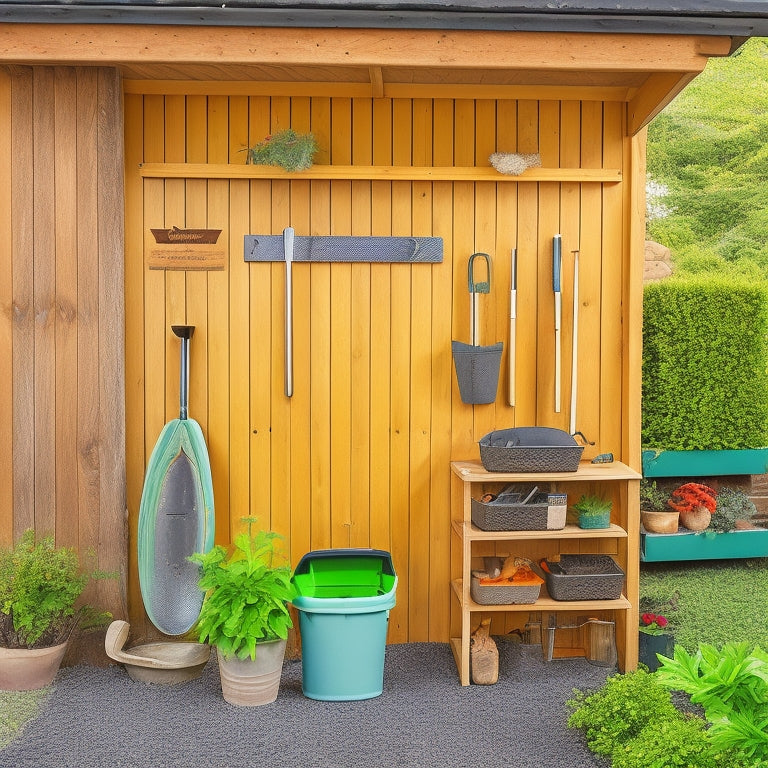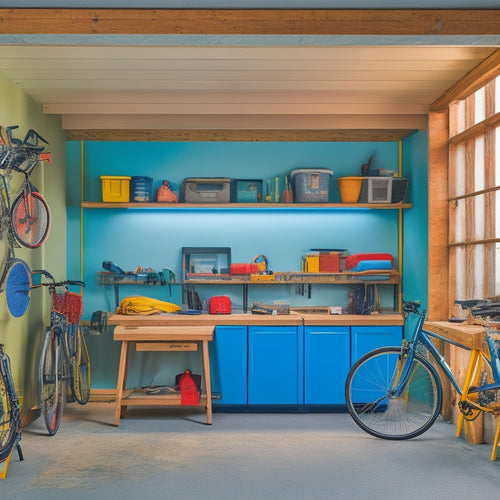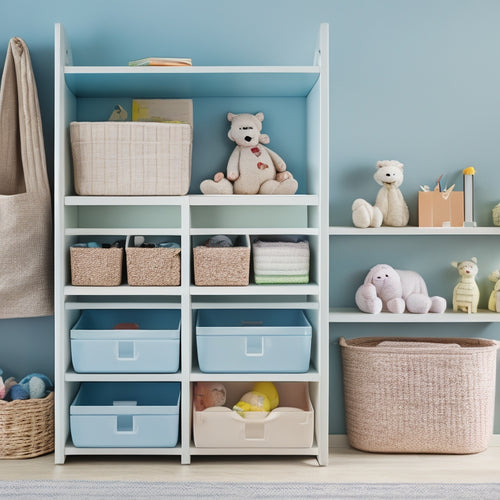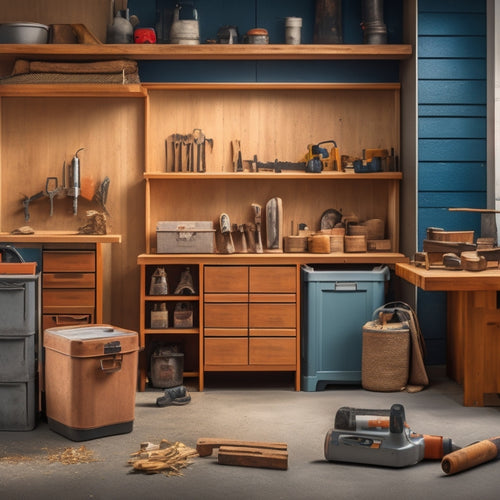
What's the Best Way to Store Landscaping Tools?
Share
You need a customized tool storage system that adapts to your unique landscaping workflow, reducing clutter and increasing productivity while prioritizing tool ergonomics for comfort and accessibility. Consider your specific tool storage options, guaranteeing easy access for efficient workflow. Create a customized tool layout, evaluating available space and tool inventory, and categorizing tools into groups for easy retrieval. By doing so, you'll be well on your way to a streamlined tool organization system that boosts your productivity. Now, take the next step to optimize your tool storage and discover the full range of benefits that come with it.
Key Takeaways
• Customize tool storage to fit unique landscaping needs, considering ergonomics and accessibility for comfort and productivity.
• Design a tool organization system that adapts to workflow, guaranteeing tool accessibility and reducing clutter.
• Choose durable, weather-resistant storage materials that protect tools from elements, pests, and moisture.
• Utilize vertical storage solutions, such as pegboards and shelves, to maximize storage space and reclaim floor space.
• Implement a clear labeling and signage system for easy tool identification and retrieval, saving time and reducing frustration.
Customized Tool Storage for Landscapers
Customize your tool storage to fit your unique landscaping needs by investing in a system that adapts to your workflow, reduces clutter, and increases productivity. As a landscaper, you know that every minute counts, and a well-organized tool storage system can make all the difference.
Consider your tool ergonomics - the way you use and interact with your tools. A customized system should prioritize comfort and accessibility, reducing strain and fatigue.
Your landscaper lifestyle is unique, and your tool storage should reflect that. Think about your specific needs and habits. Do you have a lot of bulky equipment? Do you work in tight spaces? A customized system can accommodate your specific requirements, ensuring that you have what you need when you need it.
Designing a Tool Organization System
When designing a tool organization system, you'll need to take into account three key points:
- the type of tool storage options that fit your needs,
- how to guarantee tool accessibility, and
- creating a customized tool layout.
By weighing these factors, you can create a system that streamlines your workflow and saves you time.
Tool Storage Options
You'll need to assess your available space and tool inventory to determine the most effective tool storage options for your landscaping business. Take stock of the tools you have, their size, and frequency of use. This will help you decide on the most suitable storage solutions. Consider categorizing your tools into groups, such as pruning, mowing, and digging, to facilitate easy retrieval.
Storage bins are an excellent option for storing small to medium-sized tools like hand pruners, trowels, and cultivators. Label each bin clearly so you can quickly identify what's inside.
For larger tools like lawn mowers, hedge trimmers, and chainsaws, consider investing in a shelving system or a tool chest with separate compartments. This will keep them organized, protected, and out of the way. Remember to keep your most frequently used tools in easy-to-reach locations to save time and increase productivity.
Tool Accessibility Matters
Often, a well-designed tool organization system can greatly reduce downtime and boost productivity by ensuring that the tools you need are readily available. When designing your system, you'll want to prioritize tool convenience. This means considering how you can make it easy to grab the tools you need, when you need them.
Think about the flow of your workflow and the tools you use most frequently. You'll want to store these tools in an easily accessible location, such as near the entrance of your storage area or at waist-level on a pegboard.
However, you may face accessibility challenges, such as limited space or a large number of tools. To overcome these challenges, consider using multi-tiered shelving or a tool chest with dividers. These solutions can help you maximize your storage space and keep your tools organized.
Customized Tool Layout
To design an effective tool organization system, start by categorizing your tools into groups based on their frequency of use, similarity in function, or the projects they're used for. This will help you create a logical layout that streamlines your workflow.
Next, identify the most frequently used tools and allocate prime storage space for them, ensuring easy access and minimizing travel time.
Consider the tool patterns you've developed over time. Do you always reach for the same set of tools for a specific task? Group these tools together to create a convenient 'tool station.' This layout efficiency will save you time and energy in the long run.
As you design your customized tool layout, think about the flow of your work process. Store tools in a way that mirrors the order in which you use them. For instance, place pruning shears near the gardening gloves, and position the rake close to the trowel.
Selecting the Right Storage Materials
You're one step closer to organizing your landscaping tools efficiently. Now, it's time to select the right storage materials.
Three essential factors when choosing the right storage materials for your landscaping tools are durability, accessibility, and protection from the elements. You want your storage solution to withstand the rigors of outdoor use, be easy to access, and shield your tools from harsh weather conditions.
When considering material durability, consider plastic alternatives that can resist corrosion, rust, and decay. They're often more affordable and require less maintenance than traditional metal or wooden options. Additionally, plastic storage materials are often more resistant to pests and moisture, safeguarding your tools remain in good condition.
Look for storage solutions with a durable, weather-resistant coating or finish to safeguard your tools are protected from the elements. By choosing the right storage materials, you'll be able to keep your landscaping tools organized, protected, and within easy reach. This will save you time and energy, allowing you to focus on what matters most - getting the job done.
Tool Pegboard Configuration Options
Configuring a pegboard to meet your specific tool storage needs requires careful consideration of the layout. A well-planned design can greatly enhance your workflow efficiency. You'll want to think about the types of tools you'll be storing, how often you use them, and the space you have available.
Consider grouping similar tools together, such as all your pruning tools in one section, to make them easy to access. You can also use dividers or bins to separate and organize smaller items like screws or nails.
When it comes to pegboard personalization, the options are endless. You can customize your board with different hook types, bins, and accessories to fit your specific needs. For example, you might add a magnetic strip for storing small metal tools or a tray for holding oils and lubricants.
Board customization is key to creating a system that works for you, so don't be afraid to get creative and experiment with different layouts until you find one that feels intuitive and efficient.
Creating a Portable Tool Station
By designing a portable tool station, you can extend your tool organization system beyond the pegboard and workshop, allowing you to carry essential tools and supplies to job sites or around the yard. This mobile workstation will help you stay organized and efficient, even when working on larger projects.
When choosing a portable tool station, consider the following factors:
| Feature | Consideration |
|---|---|
| Station Size | Compact enough to fit in your vehicle, but large enough to hold necessary tools |
| Tool Wheels | Durable, heavy-duty wheels for easy transport over various terrain |
| Storage Compartments | Multiple compartments to keep tools and supplies organized and within reach |
A well-designed portable tool station will keep your tools protected and within easy reach, saving you time and energy. Look for one with a sturdy frame, secure storage compartments, and durable tool wheels that can handle rough terrain. By investing in a high-quality portable tool station, you'll be able to tackle any landscaping project with confidence and efficiency.
Maximizing Garage Storage Space
Your garage's walls, ceiling, and floor offer valuable storage real estate, waiting to be optimized with clever layouts and strategic tool arrangements to keep your landscaping equipment and supplies organized and easily accessible. By maximizing your garage storage space, you'll create a more efficient and functional area that enhances your workflow.
Start by evaluating your garage's layout and identifying areas that can be improved. Consider the garage aesthetics and how you can maintain a clean, clutter-free environment while storing your tools. Corner utilization is key, as these often-wasted spaces can be transformed into valuable storage areas with the right shelving and organizational systems.
Install hooks, bins, and baskets to keep frequently used items within easy reach. Label each storage compartment to make sure you can quickly find what you need. By optimizing your garage storage space, you'll save time, reduce frustration, and create a more enjoyable landscaping experience.
Utilizing Vertical Storage Solutions
To further capitalize on your garage's storage potential, you'll want to turn your attention to the walls and ceiling, where vertical storage solutions can help you reclaim valuable floor space. By installing wall anchors, you can hang tools like rakes, shovels, and pruning shears, keeping them organized and easily accessible. This will also help prevent them from getting damaged or lost.
Overhead bins are another great option for storing landscaping tools. These bins can be attached to the ceiling, providing a secure and dust-free space for storing items like seed starters, gardening gloves, and fertilizers. Look for bins with clear lids to make it easy to identify what's inside.
Additionally, consider installing a pegboard on a wall or the back of a door, where you can hang smaller items like trowels, cultivators, and irrigation tools. By utilizing vertical storage solutions, you'll be able to store more tools in a smaller area, keeping your garage organized and clutter-free.
Incorporating Cabinets and Shelves
When incorporating cabinets and shelves into your landscaping tool storage, you'll want to explore a tool organization system that keeps frequently used items within easy reach.
You'll also need secure storage options to protect valuable equipment from theft or damage.
Tool Organization Systems
Effective tool organization systems, incorporating cabinets and shelves, streamline your landscaping workflow by providing a dedicated space for every tool, eliminating clutter and saving you time. By implementing a well-designed tool integration system, you can guarantee that every tool has its designated spot, making it easy to find what you need when you need it. This not only saves time but also reduces frustration and increases productivity.
When it comes to space efficiency, a well-planned tool organization system can help maximize your storage space. By using wall-mounted shelves and cabinets, you can utilize vertical space, freeing up floor space for other essential items. Additionally, consider using dividers and compartments to separate tools by type or function, ensuring that similar tools are stored together. This will help you quickly identify where a specific tool is located, making it easier to access what you need.
Secure Storage Options
You'll find that incorporating cabinets and shelves into your secure storage options provides a robust solution for safeguarding your landscaping tools and equipment. These storage solutions offer a high level of protection against theft, damage, and loss.
By installing cabinets and shelves in your shed or garage, you can keep your tools and equipment organized, out of sight, and out of reach from potential thieves.
To further enhance security, consider investing in padlock systems that can be attached to your cabinets and shelves. These systems provide an additional layer of protection, making it even more difficult for unauthorized individuals to access your tools and equipment.
Additionally, consider installing shed alarms that will alert you in case of any suspicious activity. These alarms can be especially useful if you store valuable equipment or have a large collection of tools.
Customized Shelf Designs
By incorporating cabinets and shelves into your storage solution, you can optimize your space by designing customized shelves that accommodate your specific landscaping tools and equipment. This approach allows you to maximize your storage capacity while ensuring easy access to your tools.
When designing your shelves, consider the shelf aesthetics, ensuring they blend seamlessly with your existing storage setup. You can choose from a variety of materials, such as wood, metal, or plastic, to create a cohesive look.
In addition to aesthetics, prioritize shelf durability. Landscaping tools can be heavy, so it's essential to choose shelves that can withstand the weight. Look for shelves with sturdy frames, reinforced corners, and a weight capacity that exceeds your tool collection's total weight.
You may also consider adding dividers or compartments to keep your tools organized and prevent damage. By investing in customized shelves, you'll enjoy a clutter-free workspace, reduced tool damage, and increased productivity.
With a well-designed storage system, you'll be able to tackle landscaping projects with confidence and efficiency.
Labeling and Signage for Easy Access
Assigning clear labels and signage to your landscaping tool storage areas enables quick identification and retrieval of the equipment you need. This saves you time and reduces frustration when you're in the middle of a project.
To make the most of labeling and signage, consider using color coding to categorize your tools. For example, you can use blue labels for pruning tools, green for gardening tools, and yellow for irrigation equipment. This visual system helps you quickly locate the tools you need.
When it comes to label placement, make sure to position them in a way that's easy to read. You can place labels on the outside of storage bins, on shelves, or even on the tools themselves. Consider using labels with bold fonts and bright colors to make them stand out.
Additionally, consider adding signage to larger storage areas, such as sheds or garages, to indicate what types of tools are stored inside. By implementing a clear labeling and signage system, you'll be able to find what you need in no time, allowing you to get back to work on your landscaping projects.
Adapting Storage for Specific Tools
Now that you've organized your storage space, it's time to think about how to store specific tools.
You'll find that certain tools, like rakes and pruning shears, require special consideration when it comes to storage.
Tool-Specific Storage Ideas
You'll find that adapting storage for specific tools, such as hedge clippers and pruning saws, requires a thoughtful approach to maximize efficiency and protection. By tailoring your storage solutions to the unique needs of each tool, you'll guarantee they remain in top condition and are easily accessible when you need them.
Here are some tool-specific storage ideas to get you started:
-
Tool Cubbies: Designate a specific compartment for each tool, making it easy to grab what you need without having to dig through a cluttered storage bin.
-
Bucket Organizers: Use a bucket with individual compartments to store small tools like pruning shears, gloves, and twine.
-
Hanging Storage: Suspend tools like hedge clippers and loppers from hooks or a pegboard to keep them off the floor and out of the way.
-
Divided Trays: Organize small parts and accessories like screws, nuts, and bolts in divided trays to prevent them from getting lost.
-
Protective Cases: Store sensitive tools like chainsaws and trimmers in protective cases to shield them from the elements and prevent damage.
Rakes and Pruning Shears
Two of the most essential landscaping tools, rakes and pruning shears, require tailored storage solutions to maintain their performance and longevity.
You'll want to make sure your rakes are hung or stored upright to prevent damage to the tines or handle. This will also help prevent rust and corrosion. Regular rake maintenance, such as cleaning and oiling, will also extend its lifespan.
For pruning shears, it's important to store them in a dry place, away from direct sunlight, to prevent rust and corrosion. You should also clean and sharpen them regularly to maintain their cutting performance. Shear sharpening is a simple process that can be done with a whetstone or sharpening steel.
By storing your pruning shears properly, you'll be able to make clean cuts and prevent damage to the blades.
Frequently Asked Questions
Can I Store My Landscaping Tools in an Outdoor Shed?
As you tuck your tools away, consider a shed that's a fortress for your gear - with shed organization systems and robust shed security features, you'll sleep better knowing your landscaping tools are safe and sound.
How Often Should I Clean My Tool Storage Area?
You should clean your tool storage area regularly, ideally after each use, to prevent rust and damage. Perform tool maintenance by wiping down tools and inspecting for damage during regular inspections to extend their lifespan.
Are There Any Specific Storage Options for Sharp Tools?
When storing sharp tools, you'll want to prioritize protection and safety. Consider using tool coatings or edge protectors to prevent damage and rust, and always store them in a secure, dry place, away from children and pets.
Can I Use a Trailer to Store and Transport My Tools?
You can definitely use a trailer to store and transport your tools, but don't forget to prioritize trailer organization with dividers and bins, and trailer security with locks and anchors to keep your gear safe on the go.
Do I Need to Store My Tools in a Climate-Controlled Environment?
'In ancient Greece, philosophers pondered the meaning of life; today, you contemplate the ideal storage conditions for your landscaping tools. You'll want to shield them from humidity levels above 60% and temperature fluctuations to prevent rust and corrosion.'
Related Posts
-

7 Essential Foldable Workbenches for Garages
When selecting a foldable workbench for your garage, you'll want to contemplate factors such as space-saving design, ...
-

Storage Bins for Shelves to Keep Clutter at Bay
You're looking for a way to keep your shelves organized and clutter-free, and storage bins are the perfect solution t...
-

Tool Storage Chests for a More Organized Workspace
You're looking to enhance productivity and reduce stress in your workspace by getting your tools organized, and that'...


